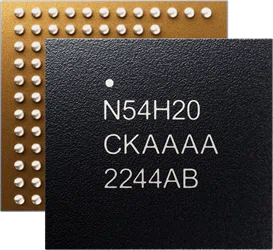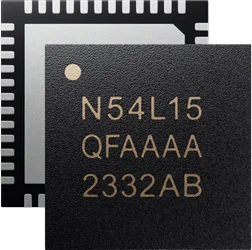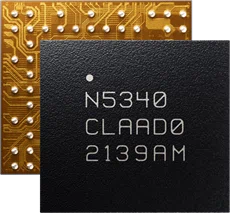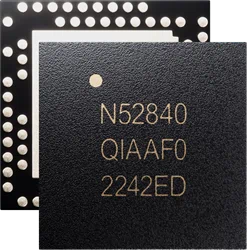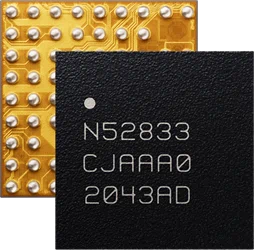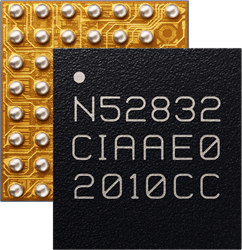New ranging features
Unlock new application areas and explore enhanced possibilities for existing products with reliable and accurate ranging capabilities, effective over both short and longer distances.
Channel Sounding is a key feature of the Bluetooth core specification 6.0. It enables accurate and secure distance measuring with built-in security features and seamless interoperability. The nRF54L Series support channel sounding.
Nordic Distance Toolbox (NDT) is an alternative proprietary ranging solution from Nordic based on well proven measurement methods. The nRF52 and nRF53 Series support NDT.
Channel Sounding at a glance

This new Bluetooth feature utilizes various ranging techniques and security measures to enable secure and accurate distance measurement between two devices without increasing product complexity or size. Channel Sounding accuracy meets the requirements for applications such as smart door locks, home appliances, personal item tracking tags, or the presence detection of high-value assets in industrial and professional settings.
- The Bluetooth specification defines new features of the radio (PHY), features of the controller, security measures, and measurement procedures needed to collect raw data
- The conversion of raw data into the resulting distance using dedicated algorithms is performed at the application level and is outside the scope of the Bluetooth specification
- A typical channel sounding setup consists of an Initiator and a Reflector, where the Initiator performs the calculations, and the Reflector can be a very simple ultra-low-power device, such as a location tag
- The configuration of the measurements and the algorithms can be adjusted to balance the required accuracy, latency, security, and power consumption
- Before the measurement, devices need to pair and establish an encrypted LE-ACL connection
- Several ranging-specific mechanisms, including randomization, defense against symbol manipulation, and attack detection provide the security of the measurement itself
- Phase-based ranging (PBR) and round-trip time (RTT) are the two possible measurement methods, which can be used independently or combined for finer ranging or coarser ranging over longer distances
- PBR and RTT measurements can be cross-checked against each other to increase the confidence level of the measurement
- Basic hardware setups can use a single antenna, maintaining a design identical to standard Bluetooth Low Energy devices for simple and compact products
- Advanced hardware setups with multiple antennas are possible for products with requirements for higher accuracy and robustness
- Compared to other ranging solutions, Channel Sounding is standardized and included in the Bluetooth qualification program
- The adoption of Channel Sounding in mobile phones and a broad range of Bluetooth devices will enable many possibilities for new use cases with Bluetooth products from different vendors
- Low-power consumption is assured by using Bluetooth Low Energy radio, as the Channel Sounding procedure consumes the same amount of power as regular data transfer
Use Cases
For Channel Sounding

|
Improved TagsTags for personal items have been a great help and have improved our lives for years. However, there are scenarios where they cannot assist, such as when keys or a remote are buried deep under sofa cushions. The common approach to addressing scenarios where the user is in proximity to a tag but still can't find it involves using vibration or sound. With Channel Sounding, these situations can be managed through 'cold-hot' indications based on distance measurements. |
 |
Smart LocksReliable presence detection with a robust protection against man-in-the-middle and relay attacks is the key requirement for smart locks. However, these features can also enhance or enable other applications. |
 |
AppliancesPresence or distance contextualization enables significant improvements in the user experience area. Physical context information provided with Channel Sounding can be particularly useful in scenarios involving multiple devices, as well as in safety features that activate control functions only when the user is in close proximity to the device. |
Asset trackingIdeal for high-value asset tracking as well as item finding in professional environments, Channel Sounding enhances these use cases with greater reliability without adding complexity to the designs. |
|
 |
Yet to be discoveredEvery major Bluetooth feature, such as Channel Sounding, introduces a spectrum of possibilities for entirely new applications and products. |
Adoption of Channel Sounding
The Bluetooth 6.0 specification defines Channel Sounding up to the point where the raw data is collected by the Initiator. As the industry advances, there is a significant focus on developing algorithms to convert this raw data into accurate ranging estimates. While this technology can be implemented on any Bluetooth 6.0 device, mobile phones are expected to primarily boost the adoption of Channel Sounding. Phones are set to manage the algorithmic tasks, enabling the development of simple and interoperable products that perform seamlessly in the Reflector role. Support for Channel Sounding has already been seen in the APIs following the release of Android 15, with support in iOS being highly anticipated.
All products in the nRF54 Series features a new radio, built on years of Nordic experience and from the ground up to support Channel Sounding. The nRF54L15 is the first generally available product from Nordic Semiconductor to support Bluetooth Channel Sounding.
Channel Sounding SoCs
nRF54 Series
Nordic Distance Toolbox

Nordic Distance Toolbox is a proprietary solution from Nordic, serving as an alternative to Channel Sounding. It offers advanced distance measurements and proximity sensing capabilities, utilizing Phase-Based Ranging (PBR) and Round-Trip Time (RTT) methods. The accompanying software library includes an algorithm that accurately determines the distance between two NDT-enabled devices, significantly enhancing accuracy compared to solutions based solely on Received Signal Strength Indicator (RSSI). This improved accuracy enables the implementation of applications that were previously unfeasible with RSSI alone, opening up new possibilities in various sectors. NDT is supported on selected SoCs from the nRF52 and nRF53 Series, making it a versatile tool for developers.
The Sample in nRF Connect SDK demonstrates the functionality of Nordic Distance Toolbox: Bluetooth: nRF Distance Measurement with Bluetooth LE discovery
Short introduction video
In-depth webinar
Nordic Distance Toolbox SoCs
nRF53 and nRF52 Series
